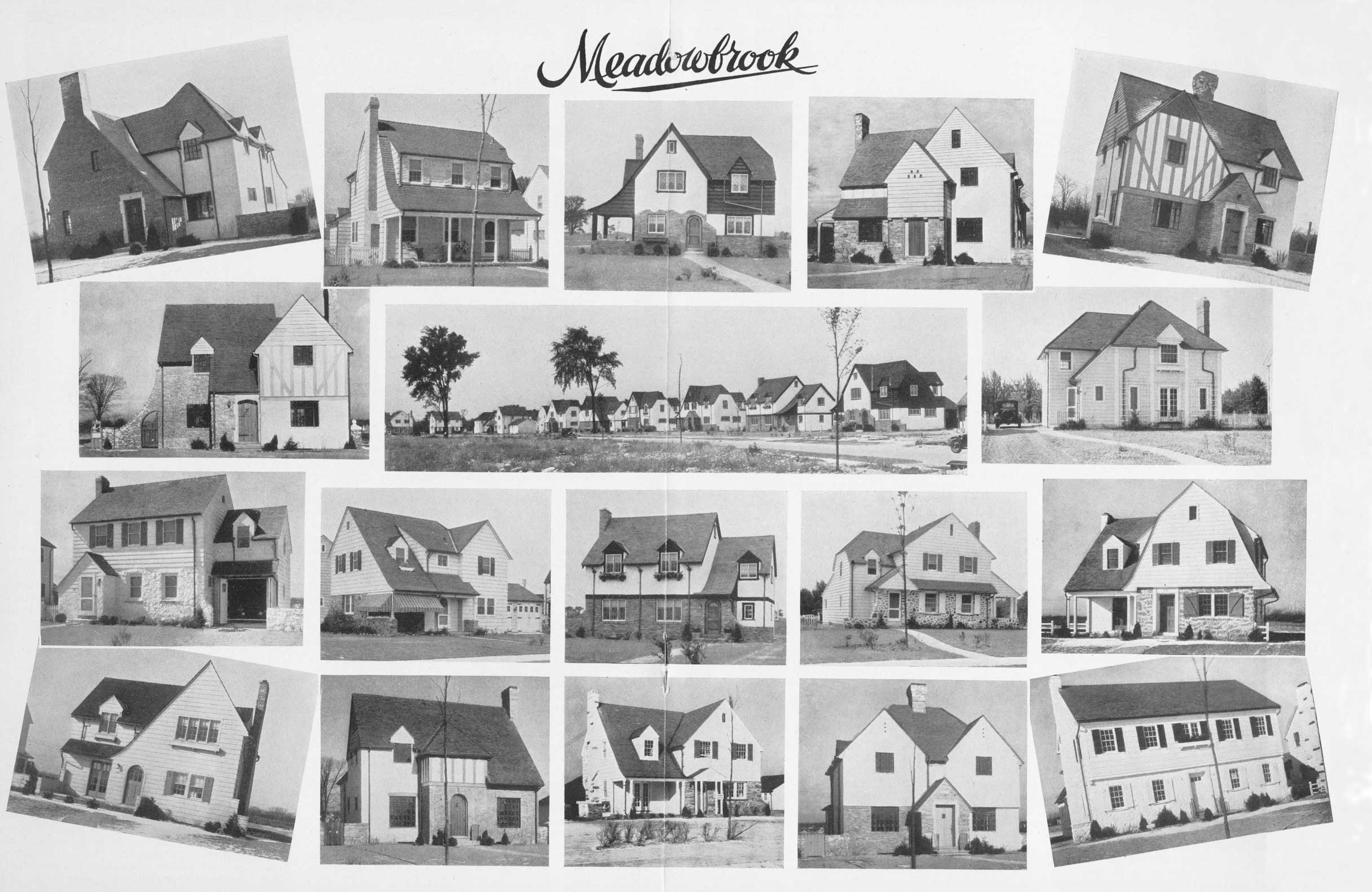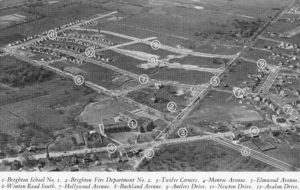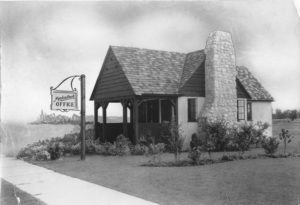Throughout its early years the population of Brighton grew slowly, probably because of its rural character. After World War I, Brighton’s rapid growth as a suburban town began. Around 1920, the Monroe Avenue area was being developed from the city-line near Cobbs Hill to Twelve Corners, thus linking downtown offices with new neighborhoods such as Home Acres, Roselawn, and eventually the Barnard Tract. The Home Acres development, situated to the west of Brighton Town Hall between Elmwood and Highland Avenues, was built on curving streets with attractive homes typical of the early 1900’s. The Houston Barnard Tract, one of the most ambitious and elaborate developments east of Rochester, was actually a financial failure at its beginning. The roads, sidewalks, and streetlights were completed but there were no houses built until after World War II’s post war building boom. It was an odd sight. Now mansions line the streets such as Sandringham Road, Esplanade and Ambassador Drives.
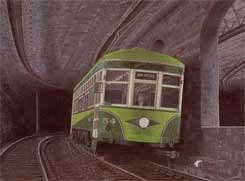
Brighton’s population continued to increase through the twenties and thirties as these developments took hold. The growth of new housing tracts brought new schools and businesses to the area. On June 7, 1922, bus service began for Brighton. The East Avenue Bus Company, whose buses replaced the inter-urban trolley lines, were running busses regularly down Monroe Avenue to Brighton. Also in 1922, the City of Rochester began work on a subway to run through the old Erie Canal bed that had been abandoned when the Barge Canal was re-routed around the city. By December 1927, the first subway car ran, making Brighton’s new neighborhoods even more accessible. However, the popularity of the privately owned automobile was still the most important factor that contributed to the practicality of suburban living.
As these housing developments arose and were filled, new communities replaced the old rural quality of Brighton. By the mid 1930s, Brighton had become a “bedroom” community and was considered, in many ways, a satellite of Rochester.
In 1921 the Kodak Employees Realty Corporation was formed. Mr. Harry D. Haight was the company’s Industrial-Relations Manager, and Mr. William R. Challice was in charge of the Realty Corporation’s housing department. Their aim was to build suitable housing for Kodak employees. This was a reaction to a severe housing shortage or Rochester’s “real-estate depression” of the early 1920’s.
The Kodak Employees Realty Corporation undertook several housing tract projects to assist employees. By 1938 almost 500 houses had been built on five company tracts. First built was a group of six houses on Rand Street. In 1924 ground was broken for the Bonesteel Tract, located in the town of Greece on the north side of Ridge Road across from Kodak Park. Homes in this area were considered modest yet well-constructed, using only quality materials. Other Kodak tracts followed, the Ardmore, the Koda-Vista, the Rowlands, and Meadowbrook. While not all lots in these tracts were sold to Kodak employees, builders were required to work under Kodak direction; all plans were fully pre-approved by the company.
Eastman Savings and Loan Association was established in 1921, the same year as the Realty Company, to further expedite the home buying process. The Association provided a safe and easy means of saving for Kodak employees and their families. It also aided employees in financing construction of their homes and was available to give advice on homebuilding.
The Meadowbrook Tract, located near Twelve Corners in Brighton, is bordered by Elmwood Avenue and Winton Road at its northeast corner. It was originally comprised of 98 acres of the Buckland Estate. The purchase of this land from Abner M. Buckland was inspired by Eastman Kodak Company’s desire to provide attractive housing for rising executives. On October 12, 1926, the Kodak Employees Realty Corporation bought the Meadowbrook Tract with a vision in mind. Meadowbrook was a radical new venture, unique in the fact that the planning and preparation for this neighborhood was conducted with unforeseen efforts in research and attention to detail.
The location of Meadowbrook, a mere 12 to 15 minutes from the city center, was advantageously situated on the Monroe-Lake streetcar line, which led past Kodak office buildings and plant. It was also located to the east of Kodak and downtown which eased the morning commute with the sunrise in back of the driver and also the evening commute with the sunset behind the drivers headed homeward.
In 1927, before any building began, the Kodak Employees Realty Company sold lot #22 on the Meadowbrook plan to Brighton’s Fire District for a new fire department at the corner of the tract.
It was desired by those heading the development that Meadowbrook homes should be constructed using only materials of the highest quality. A nation-wide tour was made of a number of outstanding sub-divisions and some of their best features were incorporated in the design of Meadowbrook. Only superior architects of national reputation, known for their dependability and pleasing originality, were used. The house plans selected were grouped to form a lovely over-all picture of a harmonious neighborhood.
All homes, of English, Colonial or Modern architecture, were to be attractive in design inside and out, with modern conveniences and solid construction from builders who prided themselves on elaborate craftsmanship.
Attention to every detail was evident from the landscaping of each lot, concrete curbs lined with elm trees, and side walks. Copper gutters and flashings and top quality cedar shingles were used for the roofs. Even the interior decoration, including light fixtures, was planned to be artistic and fashionable. All these features included an exceptional new school district and an economical purchase plan in the price range of ten to twelve thousand dollars for most houses and starting at sixteen thousand for larger houses at the northern end of the development.
In an early 1930 aerial photograph of Meadowbrook, one can see two structures that no longer exist. The first, located near the corner of Winton Road and Newton Drive, was the woodworking shop and office of George Long. Mr. Long was the builder of most of Meadowbrook’s earlier homes. The woodwork for the houses was crafted here. To the right, which was then 15 Newton Drive, was the Meadowbrook Tract office. The office was built to resemble one of the Tudor homes in the neighborhood and was attractive in its own right. It was described in the June 1938 Kodak Magazine as, ” a charming bachelor cottage. English style standing on its own landscaped plot, blended perfectly with its surroundings.” Here one could find Mr. Dan Fraysier. Mr. Fraysier, who co-coordinated the sales of Meadowbrook homes, was the link between the homeowner and the builder. Any questions the homeowner or homebuyer had were directed to him. He was usually visible throughout the neighborhood, familiarizing himself with new neighbors and the details of their homes’ construction. The only evidence of the tract office (besides the photos) that remains is the fireplace. It is located in the backyard of the home at 475 Newton Drive and is visible through the overgrowth that covers it.
In November of 1928 building began on the first houses of Meadowbrook at the eastern end of Avalon Drive and followed northward up Hollywood Avenue. The beginnings of this beautiful residential section had a heart-of-the-country appeal to prospective buyers. A visitor to the development once remarked that the houses overlooked a pasturage on one side and an orchard on the other, making it difficult to believe that the center of downtown Rochester was only minutes away by automobile.
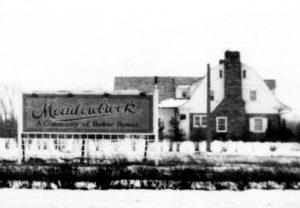
Meadowbrook was soon recognized as “A Community of Better Homes”, as advertised on a huge billboard facing Elmwood Avenue, and this became its motto. The Kodak Employees Realty Corporation made a substantial effort to promote the locale and advantages of living in the Meadowbrook neighborhood. Several articles were written for The Kodak Magazine (which later became the Kodakery) and were available to all Kodak employees. An attractive promotional booklet was written entitled ” A Trip Through Meadowbrook”, giving an elaborately detailed description and photographs of the homes being built. Click here to read the booklet.
The first three houses were sold to Roger P. Leavitt, Lyle Cassan, and Albert Meyers. Every one of the first homes built was purchased before they were completed in June of 1929. Clearly the vision and enterprise of Meadowbrook’s founders was successful. While many original homesteaders worked at Kodak, not everyone did. There was a variety of people and occupations, but the new Meadowbrookers had much in common. Most had young families and an air of excitement at establishing a beautiful new neighborhood in new surroundings. The bonding of new friends and families often lead to impromptu gatherings and eventually to more organized picnics and other functions, becoming neighborhood traditions that continue to exist today.
